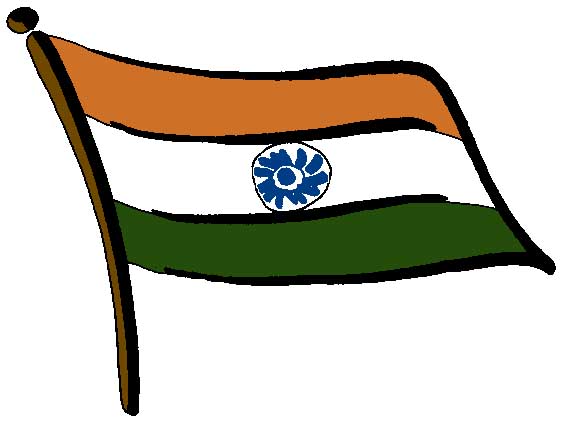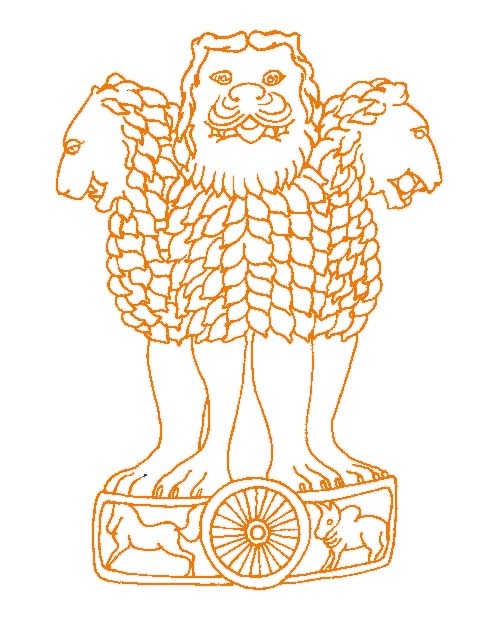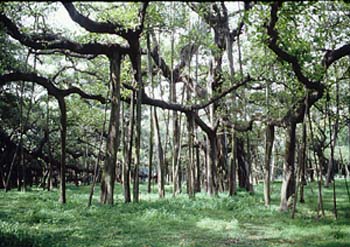
The Ashoka Chakra shall have 24 spokes equally spaced and shall preferably be screen printed or otherwise printed or stencilled or suitably embroidered with navy blue colour. In all the cases, the chakra shall be completely visible on both sides of the flag in the centre of the white panel.

The abacus is girded by four smaller animals - guardians of the four directions: the lion in the north, the elephant in the east, the horse in south and the bull in the west. The abacus rests on a lotus in full bloom, exemplifying the fountainhead of life and creative inspiration.
The motto 'Satyameva Jayate' inscribed below the emblem in Devanagari script means "Truth Alone Triumphs".
The national anthem was composed by Rabindranath Tagore in Hindi . He also composed many lovely songs and beautiful short stories which are popular with the elites as well as the rough peasants. The songs were based on the beauty of India's scenery, the beauty of women and the sufferings of the masses. He was awarded th Nobel Peace Prize in 1913 for his literary works.
Composed by Bankim Chandra, the National Song of India, appears in the Bengali novel Anand Math. The English translation of this "Vande Mataram" rendered by Shree Aurobindo, is considered to be the official and best. The first stanza of this song has been given the status of our national song.
| Sanskrit Version Vande Mataram Sujalam Suphalam Malayaja Shitalam Shasyashyamalamm Mataram ! Shubharajyothsna Pulakitayaminim Phullakusumita drumadala Shobinim Suhasinim Sumadhura Bhasinim Sujhadam varadam Mataram! |
English Version I bow to the Mother, Richly watered, richly fruited Cool with the winds of the South, Dark with the crops of the harvests, The Mother! Her nights rejoicing in the Glory of the moonlight Her hands clothed beautifully with her trees in flowering bloom Sweet of laughter, sweet of speech The Mother, giver of boons,giver of Bliss. |
| General Pledge India is my country. All Indians are my brothers and sisters. I Love my country. I am proud of its rich and varied culture. I shall always strive to be worthy of it. I shall love and respect my parents, teachers and elders. To my country and my people I pledge my devotion |
National Integration Pledge I solemnly pledge to work with dedication to preserve and strengthen the freedom and integrity of the nation. I further affirm that I shall never resort to violence and that all differences and disputes relating to religion, language, region or other political or economic grievances should be settled by peaceful and constitutional means. In theri well being and prosperity alone lies my happiness. |
NATIONAL FLOWER- Lotus

The root functions are carried out by rhizomes that fan out horizontally through the mud below the water. Lotuses, prized for their serene beauty, are delightful to behold as their blossoms open on the surface of a pond.
In India the sacred lotus is legendary and much folklore and religious mythology is woven around it.
NATIONAL BIRD- Peacock

Peacocks are found throughout India up to a height of 5000 ft. They feed on grains, vegetables, snakes, and insects. They normally roost on big trees. They are known to move only in groups. Poaching of these birds is strictly prohibited throughout India.
NATIONAL ANIMAL-Tiger

The tigers in the Sunderbans and the Himalayan regions are bigger than those found in Madhya Pradesh and in South India. Tigers normally live in evergreen forests. In the Sunderbans they lead an amphibious life.
The lifespan of a tiger is around 20 years. They hunt almost all wild animals even the big elephants.
NATIONAL TREE- Banyan

Because of this characteristic and its longevity, this tree is considered immortal and is an integral part of the myths and legends of India. Even today, the banyan tree is the focal point of village life and the village council in most areas meets under the shade of this tree.
NATIONAL FRUIT- Mango

Its juicy pulp is a rich source of Vitamins A, C and D. In India there are over100 varieties of mangoes, in different sizes, shapes and colours. Mangoes, have been cultivated in India from time immemorial.
The poet Kalidasa sang its praises. Alexander savoured its taste, as did the Chinese pilgrim Hieun Tsang. Akbar planted 100,000 mango trees in Darbhanga, known as Lakhi Bagh.
NATIONAL GAME- Hockey

During the Golden Era, India played 24 Olympic matches, won all 24, scored 178 goals (at an average of 7.43 goals per match) and conceded only 7 goals. The two other gold medals for India came in the 1964 Tokyo Olympics and the 1980 Moscow Olympics.


